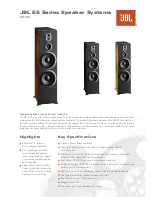
GOLDBERG AND MÄKIVIRTA
AUTOMATED IN-SITU EQUALISATION
AES 23RD CONFERENCE, May 23-25, 2003
5
Table 8. Driver level control settings.
Control Incorrect
Set-
ting
Correct Set-
ting
Bass level
–4 dB
–2 dB
Midrange level
–3 dB
–1 dB
Treble level
–2 dB
0 dB
Input sensitivity
–6 dBu
–4 dBu
The least squares type objective function to be mini-
mised is the same as shown in Equation 3. However,
a
m
(
f
) is the bass tilt and bass level combination
m
cur-
rently being tested together with the fixed midrange
and treble level ratio setting found in the previous
stage. Also,
f
1
and
f
2
now define the ‘loudspeaker pass
band’
(Table 7). High and low user selected frequency
values are permitted. The default values are the –3 dB
lower cut-off frequency of the loudspeaker and 15
kHz.
This part of the optimisation algorithm takes 35 filter-
ing steps. There are no driver level controls in two-
way or small two way systems so these virtual con-
trols are set to 0 dB. The bass tilt control can then be
optimised using the same objective function. Only
five filtering steps are required for two-way and small
two-way systems.
3.2.4. Reset Bass Roll-off
Firstly, the bass roll-off control is reset to 0 dB. Then
the same method used to set the bass roll-off earlier is
repeated, but without modifying upwards the final set-
ting. The same objective function is used as presented
in Section 3.2.1.
3.2.5. Set Treble Tilt
The least squares type objective function to be mini-
mised is the same as shown in Equation 3. However,
f
1
and
f
2
now define the ‘loudspeaker pass band’
(Table 7). High and low user selected frequency val-
ues are permitted. The default values are the –3 dB
lower cut-off frequency of the loudspeaker and 15
kHz. This part of the algorithm requires five filtering
steps for two way and large models (three for small
two way models) and is skipped for three ways be-
cause they do not have this control.
3.3. Reduction of Computational Load
The optimiser algorithm has been designed to reduce
the computational load by exploiting the heuristics of
experienced calibration engineers. The resulting num-
ber of filtering steps has been dramatically reduced for
the larger systems (Table 9) and even the relatively
simple two-way systems show a substantial improve-
ment when compared to the number of filtering steps
needed by direct search method as summarised in
Table 5. There are two main reasons for the improve-
ment; the constraint of not allowing the setting of all
three of the driver level settings simultaneously and
the breaking up of the optimisation into stages.
Table 9. Number of filter evaluations needed by the
optimisation algorithm.
Type of loudspeaker
Optimisation
stage
Large 3-way 2-way
Small
2-way
Preset bass roll-
off
6 6 6 3
Find midrange/
treble ratio
49 49 - -
Set bass tilt and
level
35 35 5 5
Reset
bass
roll-off
6 6 6 3
Set treble tilt
5
-
4
2
Total
101 96 21 13
Total re. direct
search
0.2% 1.1% 26% 81%
The run time on a PII 366 MHz computer for a three-
way system is about 15 s (direct search 3 minutes).
Large systems now take about the same time as a
three-way system (predicted direct search time was 15
minutes). The processing time is directly proportional
to the processor speed as a PIII 1200 MHz based
computer takes about 4 s to perform the same optimi-
sation. Further changes in the software have improved
these run times by about 30%.
3.4. Algorithm
Features
3.4.1. Frequency Range of Equalisation
The default frequency range of equalisation is from
the low frequency
–
3 dB cut-off of the loudspeaker
f
LF
to 15 kHz. If there is a strong cancellation in the fre-
quency response around
f
LF
, or the high frequency
level is decreased significantly due to an off-axis loca-
tion or the loudspeaker is positioned behind a screen
or due to very long measuring distance, manual read-
justment of the design frequency range (indicated on
the graphical output by the blue crosses, Figure 1) is
needed. Naturally it is preferable to remove the causes
of such problems, if possible.
3.4.2. Target for Optimisation
There are five target curves from which to select:
1. ‘
Flat
’ is the default setting for a studio monitor.
The tolerance lines are set to +/–2.5 dB.
2. ‘
Slope
’ gives a user defined sloping target re-
sponse. There are two user defined knee frequen-






































